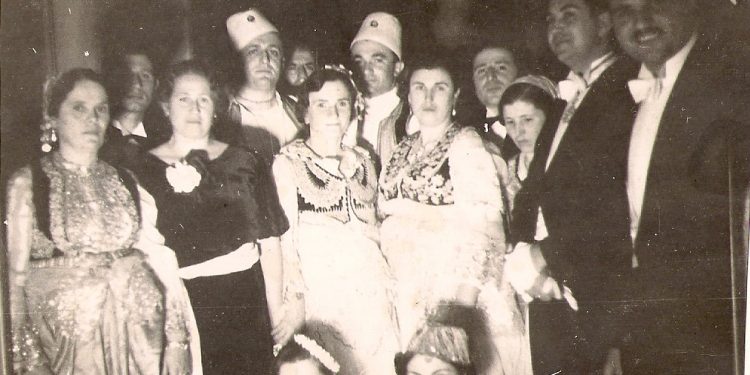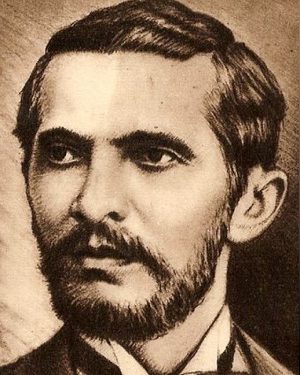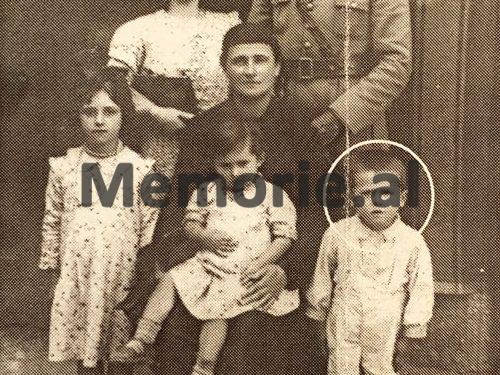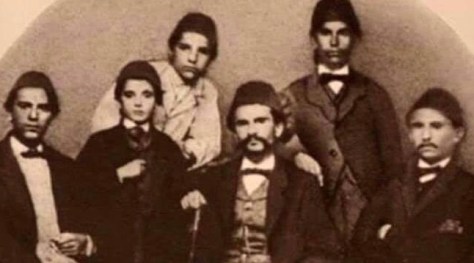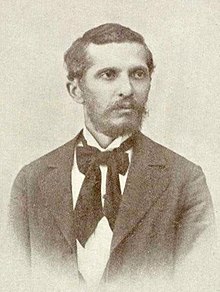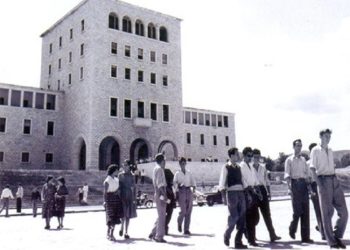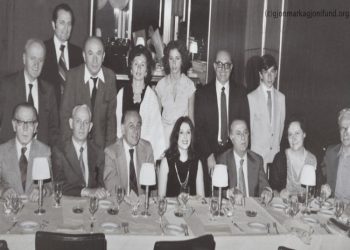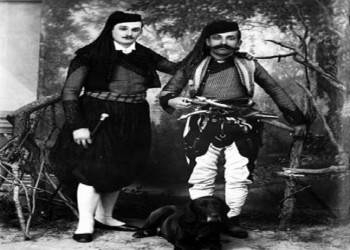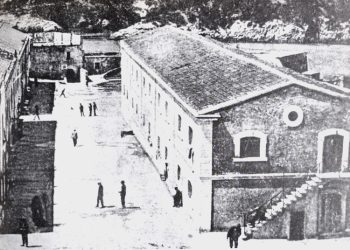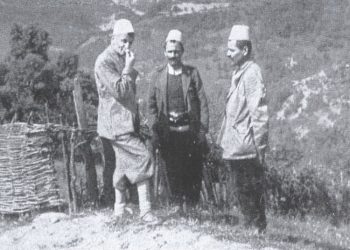The First Part
– THE POLYPHONY OF ARISTOCRATIC ALBANIANISM: THE MULTIFACETED TEQE OF FRASHËR –
Memorie.al / The Teqe (Bektashi Convent) of Frashër led Albanianism, leading the Albanian teqes from Gjakova in Kosovo, to Durballa in Thessaly, and up to Kavalla in Thessaloniki! Infinite honors and respects to Frashër and the Frashëri family, for that invaluable contribution they have given to the altar of the national cause, and for the distinguished people they have given to the National Pantheon, headed by the illustrious Frashëri brothers: Abdyl, Naim, Sami, Mehmet!
THE SALONS OF ALBANIAN ARISTOCRACY IN ALBANIA AND ISTANBUL
Evliya Çelebi, in his work “Seyahatname,” over three centuries ago, spoke of the madrasas of the time in Berat, Elbasan, Prizren, etc., and the coffee houses where the cream of the time’s intelligence held philosophical, theological, literary discussions, etc. The poets and scholars of the time were numerous, and they set the tone for intellectual life at the end of the 17th century. For over two and a half centuries, according to Hafiz Ali Korça, “Elbasan has been the center of the ulema (scholars) in Albania. There, they wrote verses of every kind, as well as rubai (Each rubai summarizes a complete thought or idea, or affirms a moral or philosophical truth expressed in verse). There, they wrote verses of every kind, as well as rubai in Arabic, Persian, Turkish, and Albanian. Due to the great fame and widespread reputation that Elbasan had, visitors came from Arabia, Persia, and Turkey.” Hafiz Ali Korça refers to two great Albanian scholars, Hasan Zyko Kamberi from Kolonja and the famous mystic, Ibrahim Nezim Frakulla of Berat, who died in Istanbul.
As informed by foreign travelers or diplomats who moved in the Pashalik of Ali Pasha Tepelena, in the salons of his saray (palace) in Ioannina and Tepelena, they encountered there or outside them learned people, scholars, and various intellectuals. But not only in the Southern Pashalik. Also in the Northern one, of the Bushatli family, or that of Ahmet Kurt Pasha of Berat. In Shkodër, we find a scholar like Isuf Tabaku, in the South, in Filat, an Osman Hoxha (father of Hasan Tahsini), or a Muhamet Kyçyku Çami, in Konispol…!
This development was also reflected in mountainous towns like Voskopoja, Vithkuqi, Frashëri, Leskoviku, Konica, etc. In Frashër, from the homes of the beys (local lords), renowned families like the Sulejmanbelli, Vilak, Skënderaj, etc., the educated people from their kinship in Tehran, Istanbul, Cairo, or some even in the West, who constituted the elite of the small mountain town, gathered in the Teqe of Nasibi, which had become a center of culture, especially oriental culture?
In this scholarly hearth, our national poet, Naim Frashëri, “received his first baptism.” There, in this “salon” of mountainous Frashër, he acquired his oriental education. There, he listened to entire divans (collections of poems) of poetry in Persian, Arabic, and Ottoman from the cultured fathers of the Frashëri Teqe. There, he got his hands on books in the three languages of the East, which were in the Teqe’s library. There, he learned the poems of Dalip and Shahin Frashëri in Albanian.
Later, with the transfer to Ioannina, in the 1860s, Ioannina, which still preserved the memory of the “Albanian Lion,” Ali Pasha Tepelena; in the salon of the classical high school “Zosimea,” he and his brother Sami would learn Greek and Latin, as well as Italian and French. Outside of it, they would perfect the languages of the East…!
In this high school, where the Frashëri brothers studied, an impassioned researcher of their life, work, and ideas has followed the traces of their schooling, such as Professor Zija Xholi, and along with him, a former employee of our embassy in Greece and later our ambassador to Turkey, Mr. Jonuz Begaj…! In the salon of this high school, our National Renaissance figures Naim and Sami, young men at the time, became acquainted with the Greco-Latin classics of the old era and with the Italian and French classics of modern times.
There, in the high school or the French consulate of Ioannina, our Naim received a request from the French Albanologist, Auguste Dozon, to collect proverbs in his homeland, in the region of Dangëllia. In the environment of the teqe, where people came and went from all four sides of the region, communicating with them, as well as with those from the surrounding regions like Skrapar, Tomorica, Opar, Kolonja, Përmet, etc., and even in the village of Frashër among the people, he carefully gleaned the proverbs and gave them to the valuable scholar Dozon, as informed by the writer from Kolonja residing in Bulgaria, Thoma Kacorri.
This connection with the French consul Dozon, from a young age, is yet another testimony that Naim had early ties, not only through books but also alive, with French culture and the people of this culture and more widely, that of Europe…!
The Teqe of Frashër and its salon were like a microcosm where all the languages spoken in Frashër, this small town amidst the mountains of Dangëllia, could be heard. Today, we cannot imagine the then multi-lingual status where a Naim, a Sami, and generally the Frashëri brothers and others were born and raised. In Frashër, besides the Bektashi Muslim neighborhoods, there was also a Christian neighborhood, and a Vlach neighborhood.
In them, there were also corresponding schools. Besides an elementary school (mejtep) in the Ottoman language, there was a Greek school (for Christians) and naturally with corresponding teachers from Frashër or elsewhere. Of course, there was also a church. Moreover, as Sami informs us in “Kamus-ul Alam” (Dictionary of the World), there were also two teqes, one of the Bektashi sect and the other of the Sa’di sect.
It is understood and historically known that the Bektashi Teqe of Frashër was the most important one, and it was transformed into the intellectual center of this mountain town. It became the “Academy” where philosophical, religious, literary, scientific, artistic, cultural, political, etc., problems were debated. There, in the teqe, all the languages spoken in the village could be heard, even though everyone was Albanian. Bektashi Muslims knew Turkish (and not only them), as it was the language of administration, school, religion, etc.
The most educated ones, who had gone as far as Iran or, without going there, spoke Persian, a language that the babas (fathers) of the teqes normally knew, as well as the dervishes and others. Also, Arabic, which was taught in the mejtep alongside Ottoman and Persian, was known by many people as the language of the Quran, the holy book, the language of Islamic liturgy in the mosque, and also in the teqe.
Orthodox Christians learned “their language,” Greek, known as the language of the Orthodox in the Balkans and the entire Ottoman Empire, thus also of the Albanian Christians. The Greek school and the church where teaching was also done in Greek, plus the trade connections with Ioannina and deeper into Greece, kept this language alive. In fact, it was known and spoken by a part (besides Christians) of the Muslims of southern Albania, including the Bektashis. Be that as it may, Greek was an ancient language of culture, inherited from antiquity and Byzantium.
No further than a horse-ride away, it was spoken and had been spoken, written, and taught in neighboring Voskopoja and Vithkuqi, mountain towns just like Frashër, but larger. Not to mention the other fact that they also had various connections as neighbors, trade, economic, cultural, blood ties, and Voskopoja was linked to Frashër through property. After the fall and burning of Voskopoja by the local warlords (derebeys), the Frashëri beys appear as feudal owners of the illustrious city of Voskopoja…!
So, in the Teqe of Nasibi in Frashër, as in the entire small town of Frashër, Persian, Arabic, Ottoman, Greek, Vlach, and finally, the connecting mortar was the only language that was not written, the language of the “stepmother,” the “Cinderella of the hearth,” which was spoken in every home. In the teqe, everyone understood each other through Albanian, this was the “international language,” the “Esperanto” that everyone understood, but which was scorned by the administrative power and whose writing was prohibited. Jail awaited you if you learned, read, or wrote Albanian. Despite the persecutions, Albanian was still taught secretly, right in the Teqe of Frashër.
In fact, they say that in a village in Skrapar, an eagle is carved on the door of a teqe, which has survived to our days, inherited from the times of the Ottoman rule. Albanians, and even more so the Bektashis, did not lack courage and bravery. The people in the teqe’s salon were united not only by the common language, since they were Albanians and learned it with their mother’s milk, but also by Albanian traditions, such as besa (faith/pledge of honor), manliness, honesty, hospitality, courage, bravery, etc.
Regarding honesty, they tell a story in a village in Skrapar or Dangëllia, that a master craftsman from Opar built a teqe. After he finished it, the Baba (Father) of the teqe called him and asked: “Ustabash (Master builder), how much is your payment (hak)?” He took a bowl full of gold and silver coins, Turkish mecidiye of the time, or gold coins from other states, like Austrian crowns, filled to the brim, and placed it before him. “Take as much as you want,” the sheikh told him.
But the master, with the honesty that characterized the people of that time who preserved Albanian customs, reached out his hand, took a few coins from the bowl, and withdrew. “This is my payment,” he said. While the baba of the teqe, with the nobility that characterized him, took gold coin and gave it to him: “This is a gift (peshqesh) from me for the high-quality work you have done for the teqe.” Such were the people of that time…
So, in a small town like Frashër, no more and no less, six languages were spoken: Persian, Arabic, Ottoman, Greek, Vlach, and Albanian, which everyone knew, which was like a language we use today but is not written in our cities, for example, the language spoken by the arixhi (a local term for a particular group of Romas/Egyptians), the Roma…! There were people who had established in their homes, or had finished lyceums, high schools, or even universities in Europe, from the noble families of Frashër, who also knew Western languages, mainly French, Italian, some German, and very rarely English…!
In this environment, Naim, Sami, and the other brothers grew up in the first decade of their lives, and then in the second decade of their lives, they would go up to Frashër, especially Naim during the summer school holidays. After resting in the Hotova Firs by the spring, he would climb the Kokojka Mountain, and then through the slope, he would hold his breath at the Teqe to meet Baba Alush, the friend of the house, heart, and blood of the Frashëri family, before going to the parental home. Then he would go to his own home, that of the Dukollars, and go to the extended family, to the kin (akraba), and then catch up with the homes and people of the neighborhoods or mahallas throughout Frashër. He did not forget to go and see the flocks of livestock and listen to their bells, especially in the Vlach neighborhood. Such was Naim.
Years later, these impressions consciously or unconsciously ingrained in his memory about the livestock, the mountains, or the pines, oaks, and straight-as-a-candle firs of Hotova, he would pour out like statues and carve them with the “master’s” soul, in the verses of his immortal work, “Livestock and Agriculture” (Bagëti e Bujqësia). In it, he would sing to the ancient, antique Tomorr and Tomorr, the holy mountain, where the gods of Albanians and Bektashis resided…! His inspiration from Tomorr would inspire and electrify all Albanians with Albanianism: “O Tomorr, O High Mountain, where the Lord resides/ According to the faith that Albanians had long ago…”!
In the “Academy” of the Frashër Teqe, in this scholarly hearth with a rich library and renowned scholars with solid oriental and local culture, in this sanctuary where Albanian culture and the moral codes and customs of Albanians were passed down from generation to generation, in this cultural hearth where conversations were held in various languages by the elite of Frashër, especially its educated, well-traveled, and world-roaming beys, in this “universe” of languages, in this place where people came, stayed, and held the most varied conversations, from philosophy and religion to literature and the culture of the East and also the West, must be sought the foundations of the polyhedral, encyclopedic culture of our chief poet, the “Nightingale” of Frashër.
The “Nightingale” of Frashër must be taken not only in the sense that he originated from there, that this town and this area of Dangëllia or Përmet produced him, meaning where he came from, but also in the deeper sense that it is Frashër, its Bektashi teqe, and its “salon,” that laid the foundations of his formation as a person, as a humanist, as a pantheist, as an Albanian with a capital A, and right here were laid the foundations of his future culture as a poet, but also as a scholar, as an erudite and polyglot who mastered over 10 languages…!
But let us leave the Frashër Teqe, this “Little Academy,” which prepared our great Naim and Sami, for a few moments, and follow their life journey towards Istanbul, the capital of the Ottoman Empire, where our two coryphaei, and most of our most important National Renaissance figures, cast the waves of their lives…! In this enormous city, a crossroad of cultures of different peoples of the Balkans, Anatolia, the Caucasus, Southern Europe and the Mediterranean and beyond, the Middle East, North Africa, Central Asia, Ukraine and Crimea, Iran, India, etc., etc.
There, at that meeting point of ancient and new cultures, of East and West, of North and South, there at that confluence of three continents, they would consolidate themselves as philosophers and scholars, as poets and writers devoted to their own people, as true Albanians…! Naim in Istanbul was a frequent guest in the two konaks (large houses/mansions), the salons of Munif Pasha, the Minister of Education at the time he worked in this ministry, and even earlier in the early 1870s, together with Hoxha Tahsini and his brother Sami Frashëri…!
These two salons were very close to the Ottoman Ministry of Education, one in Nuruosmaniye and the other in Suleymaniye. Educated women, intellectuals, and poetesses also participated in them, plus scholars, from Persia, Pakistan, India, Arabia, Egypt, but also from Norway…! Intellectuals from the country, personalities of Ottoman education and culture, such as Munif Pasha, came to Hasan Tahsini’s madrasa in Istanbul, but as Sami Frashëri informs us, foreign scholars also came, such as the German Paul Gronfeld, and others.
Naim in Istanbul would work for two decades in the Ministry of Education of the Empire, and there in its salon, he would have the opportunity to listen to and participate in the receptions and send-offs of local and foreign personalities. I have been on the third or fourth floor of this building, today the Istanbul Press Museum (“Press Museum” or “Basın Müzesi”), and there is the library hall of this institution.
But I imagine this enormous salon, where conferences were held, to which foreigners came from all over the world at that time, Hungarian scholars like Ármin Vámbéry, a close friend of Sami Frashëri, etc. Naim, in the role of Deputy Minister, perhaps alongside Munif Pasha, the head of that ministry, received and saw off these distinguished people of different nations, such as the academician of the Hungarian Academy of Sciences, Vámbéry, etc.
It is interesting that a few years ago when I was in Istanbul, I came across material that confirmed that in the same building where the Ottoman Ministry of Education was located, the first Ottoman university had opened more than a decade earlier, and from its balcony, its first rector, Hoxha Tahsini, had addressed over 1,000 students (talebes) at its inauguration. Some of the scientific conferences that were held in the month of Ramadan for students and others were also held in the salon in question.
Naim Frashëri, our Naim, also went to the salons of the Armenian or Rûm (Greek Orthodox) Christians of Istanbul in the “Fener” or “Balata” neighborhoods, etc., in their salons where the cream of Istanbul’s intelligence gathered. It is of interest to emphasize a meaningful fact. After the death of Hoxha Tahsini, a directorate of the Ministry of Education was installed in his madrasa after 1881, where Naim might have worked. What our poet must have felt, being in the same building where the National Renaissance figure Hasan Tahsini had lived, or the other fact that the building of the Ministry of Education had previously been the building where the first Ottoman university, founded by Tahsini, was opened.
The salons of the Vlora family, whether of the branch of Ismail Qemali, the greatest diplomat of the Ottoman Empire, or of the other branch of Syrja and Eqerem Bey Vlora, whether in Vlora or Istanbul, lacked nothing compared to those of the Ottoman Prime Ministries. The salons of the grand viziers like Ali Pasha, etc., who also had connections with our National Renaissance figures, where the table was set for 200-300 people every day, were intellectual nests for the cream of the Ottoman and also Albanian elite…!
The houses of Pashko Vasa, Ismail Qemali, high Ottoman officials, and Abdyl Frashëri (a deputy in the Ottoman parliament), in Beyoğlu, in the heart of Istanbul, were centers of the Albanian patriotic movement. In their salons, political and patriotic conversations took place and historical decisions were made, such as the one for the declaration of independence, 30 years after the League of Prizren.
In the house of Abdyl Frashëri, in Mercan Yokuşu (Mercan Slope), as you exit the Kapalı Çarşı (Grand Bazaar/Gold Market in Istanbul), the historical meeting that marked the founding of the Society for the “Printing of the Albanian Alphabet” (Shoqëria e të Shtypurit Shkronja Shqip) was held. The signatories of its kanonizma (statute) gathered in its modest salon.
The houses of Naim and Sami Frashëri in the European part, and then in the Asian part of Istanbul, were venues for intellectual and patriotic gatherings. Scholars from the East and the West came there. Priests and hodjas (Muslim clerics) stayed side by side, as well as the Bektashi sheikh and the Jewish rabbi, as informed by the Albanologist Peter Bartl or Midhat Frashëri, and some other source. When the reception salon could not hold them all, they moved to the garden.
The large salons were not unfamiliar to our National Renaissance figures. Thus, Naim had been many times in the salon of the French Lycée of Galatasaray, where French professors, ambassadors, and foreign consuls, lyceum students, and others assisted in scientific gatherings. Naim Frashëri’s participation at the end of the 19th century in the American College for Girls in Üsküdar (a district of Istanbul in the Asian part), at the graduation ceremony of its graduates, including Sevasti Qiriazi, is now well known. The American ambassador of the time was also present in that salon./ Memorie.al
Continues in the next issue




